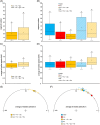Diet acts on sexual behavior development in a male moth
- PMID: 39402830
- PMCID: PMC12369456
- DOI: 10.1111/1744-7917.13457
Diet acts on sexual behavior development in a male moth
Abstract
In many animals, drastic changes are observed during sexual maturation characterized by the reproductive system development concomitantly to the sexual behavior ontogenesis. These modifications are under the control of internal and external factors such as food. Sexual maturation requires considerable energetic investment, and diet has been shown to affect reproductive activities in many taxonomic groups, especially in insects and vertebrates. By contrast, diet effects on sexual behavior development remain largely unexplored. To elucidate this aspect, we used the male moth Agrotis ipsilon which undergoes sexual maturation occurring between the third and the fifth day postemergence. During this period, males are sensitive to female sex pheromones and a stereotypical sexual behavior characterized by female-oriented flight takes place. In our study, we compared (1) sex pheromone detection by electroantennography recordings and (2) behavioral response in wind tunnel assays between males fed with different diets found in nature. Compared to standard sucrose diet, males fed with sucrose, fructose, and glucose supplemented with sodium (a mineral element necessary for the locomotor activity in several moths) did not respond better to female sex pheromones but clearly exhibited an earlier behavioral response. Thus, such a diet accelerates the development of sex pheromone-mediated oriented flight, probably by facilitating the central processing of sex pheromone information in male A. ipsilon moths. Our results provide new information on the influence of nutritional intake on the ontogenesis of male sexual behavior in animals.
Keywords: Agrotis ipsilon; feeding; insect; oriented flight; sex pheromone detection; sexual maturation.
© 2024 The Authors. Insect Science published by John Wiley & Sons Australia, Ltd on behalf of Institute of Zoology, Chinese Academy of Sciences.
Figures




References
-
- Aguilar, P. , Bourgeois, T. , Maria, A. , Couzi, P. , Demondion, E. , Bozzolan, F. et al. (2023) Methoprene‐tolerant and Krüppel homolog 1 are actors of juvenile hormone‐signaling controlling the development of male sexual behavior in the moth Agrotis ipsilon . Hormones and Behavior, 150, 105330. - PubMed
-
- Ankola, K. , Aishwarya, D. , Anusha, R. , Vaishnavi, N. , Supriya, V.K. and Puttaraju, H.P. (2021) Ecological significance of puddling as a behavioural phenomenon in the life history of butterfly Papilio polytes Linn. (Lepidoptera: Papilionidae). Journal of Asia‐Pacific Entomology, 24, 1–6.
-
- Axon pCLAMP 11. [WWW Document] (2023) (accessed 3.5.23) URL https://fr.moleculardevices.com/products/axon‐patch‐clamp‐system/acquisi...
MeSH terms
Substances
LinkOut - more resources
Full Text Sources

